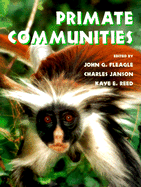Book contents
- Frontmatter
- Contents
- List of contributors
- Preface
- 1 African primate communities: Determinants of structure and threats to survival
- 2 Biomass and use of resources in south and south-east Asian primate communities
- 3 Species coexistence, distribution, and environmental determinants of neotropical primate richness: A community-level zoogeographic analysis
- 4 Primate communities: Madagascar
- 5 Primate diversity
- 6 Phylogenetic and temporal perspectives on primate ecology
- 7 Population density of primates in communities: Differences in community structure
- 8 Body mass, competition and the structure of primate communities
- 9 Convergence and divergence in primate social systems
- 10 Of mice and monkeys: Primates as predictors of mammal community richness
- 11 Comparing communities
- 12 Large-scale patterns of species richness and species range size in anthropoid primates
- 13 The recent evolutionary past of primate communities: Likely environmental impacts during the past three millennia
- 14 Resources and primate community structure
- 15 Effects of subsistence hunting and forest types on the structure of Amazonian primate communities
- 16 Spatial and temporal scales in primate community structure
- 17 Primate communities in Africa: The consequences of long-term evolution or the artifact of recent hunting?
- 18 The future of primate communities: A reflection of the present?
- 19 Concluding remarks
- Systematic index
- Subject index
6 - Phylogenetic and temporal perspectives on primate ecology
Published online by Cambridge University Press: 21 August 2009
- Frontmatter
- Contents
- List of contributors
- Preface
- 1 African primate communities: Determinants of structure and threats to survival
- 2 Biomass and use of resources in south and south-east Asian primate communities
- 3 Species coexistence, distribution, and environmental determinants of neotropical primate richness: A community-level zoogeographic analysis
- 4 Primate communities: Madagascar
- 5 Primate diversity
- 6 Phylogenetic and temporal perspectives on primate ecology
- 7 Population density of primates in communities: Differences in community structure
- 8 Body mass, competition and the structure of primate communities
- 9 Convergence and divergence in primate social systems
- 10 Of mice and monkeys: Primates as predictors of mammal community richness
- 11 Comparing communities
- 12 Large-scale patterns of species richness and species range size in anthropoid primates
- 13 The recent evolutionary past of primate communities: Likely environmental impacts during the past three millennia
- 14 Resources and primate community structure
- 15 Effects of subsistence hunting and forest types on the structure of Amazonian primate communities
- 16 Spatial and temporal scales in primate community structure
- 17 Primate communities in Africa: The consequences of long-term evolution or the artifact of recent hunting?
- 18 The future of primate communities: A reflection of the present?
- 19 Concluding remarks
- Systematic index
- Subject index
Summary
INTRODUCTION
As many studies in this volume and elsewhere have noted, there are persistent differences in the ecological characteristics of the individual species assemblages found on different continents (Terborgh & van Schaik, 1987; Fleagle & Reed, 1996; Kappeler & Heymann, 1996). For example, the primates of the Neotropics tend to be smaller and less ecologically diverse than those of other continents, while Madagascar has a larger number of folivores than other biogeographical areas. It seems almost certain that the differences between the primate assemblages of different biogeographical regions are the result of many causal factors and their interactions, including differences in productivity, in the composition of the plant communities, in climate and soil, and in the potential for competition with other groups of vertebrates. These factors are examined in other chapters of this volume.
However, the primate assemblages we see today are not simply epiphenomena of present ecological conditions. Rather, they are also the product of evolutionary and ecological processes that have been ongoing for millions of years. Environments are not stable today, and they never have been; they are constantly changing. The temporal scale of environmental change ranges from decades and centuries for human-induced activities of habitat destruction such as logging, land clearing, hunting, or introduction of exotic species (Struhsaker, chapter 17, this volume) and also for natural epidemics. Global climatic cycles seem to have periodicities ranging from a few years, such as the El Niño phenomena to tens of thousands of years for the glacial cycles that have dominated the past two million years (Tutin & White, chapter 13, this volume; Potts, 1994).
- Type
- Chapter
- Information
- Primate Communities , pp. 92 - 115Publisher: Cambridge University PressPrint publication year: 1999
- 32
- Cited by



